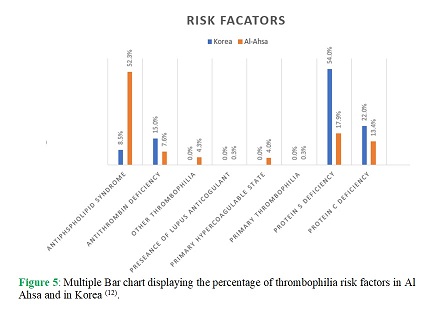
Contributions
Abstract: PB1827
Type: Publication Only
Session title: Thrombosis and vascular biology - Biology & Translational Research
Background
Background: Thrombophilia is a hypercoagulability disease that gives rise to clot formation in the blood leading to stroke, deep vein thrombosis, or pulmonary embolism. The prevalence of different risk factors associated with thrombophilia varies in different regions of the world that may impact its clinical management. However, no studies have been conducted in Al Ahsa concerning thrombophilia. Therefore, the aim of this study is to find out the risk factors associated with thrombophilia in Al-Ahsa.
Aims
Therefore, the aim of this study is to find out the risk factors associated with thrombophilia in Al-Ahsa and its comparison with other regions of the world.
Methods
Methods: This was retrospective cross-sectional study. It included 329 thrombophilia patients attending King Abdulaziz Hospital (KAH) from 2015-20. Patient data was retrieved from BestCare and was analyzed using SPSS version 20.
Results
Results: Thrombophilia was significantly more prevalent in females than males. It was most common in the age group 44-54 years (44.7%). The main risk factors associated with thrombophilia were anti-phospholipid syndrome (52.3%), Protein S deficiency (17.9%), Protein C deficiency (13.4%), anti-thrombin deficiency (7.6%), familial predisposition (4.3%) and lupus anticoagulant (0.3%). Frequencies of thrombophilia-associated risk factors in Al-Ahsa region was significantly different from Korean population (p<0.05) (Figure 5).

Conclusion
Conclusion: In our studies, female gender, anti-phospholipid syndrome, Protein S deficiency, Protein C deficiency, anti-thrombin deficiency and familial predisposition were found to be major risk factors associated with thrombophilia, respectively, that showed significant difference from other populations. These geographic variations in frequencies of different risk factors associated with thrombophilia may be attributed to different lifestyle, nutritional habits, genetic make-up and other ethnic differences in various geographical regions of the world. Strategies related to clinically manage thrombophilia in any clinical settings should consider prevalence of different genetic and non-genetic risk factors in that region.
References:
Keyword(s): Ethnicity, Risk factor, Thrombophilia
Abstract: PB1827
Type: Publication Only
Session title: Thrombosis and vascular biology - Biology & Translational Research
Background
Background: Thrombophilia is a hypercoagulability disease that gives rise to clot formation in the blood leading to stroke, deep vein thrombosis, or pulmonary embolism. The prevalence of different risk factors associated with thrombophilia varies in different regions of the world that may impact its clinical management. However, no studies have been conducted in Al Ahsa concerning thrombophilia. Therefore, the aim of this study is to find out the risk factors associated with thrombophilia in Al-Ahsa.
Aims
Therefore, the aim of this study is to find out the risk factors associated with thrombophilia in Al-Ahsa and its comparison with other regions of the world.
Methods
Methods: This was retrospective cross-sectional study. It included 329 thrombophilia patients attending King Abdulaziz Hospital (KAH) from 2015-20. Patient data was retrieved from BestCare and was analyzed using SPSS version 20.
Results
Results: Thrombophilia was significantly more prevalent in females than males. It was most common in the age group 44-54 years (44.7%). The main risk factors associated with thrombophilia were anti-phospholipid syndrome (52.3%), Protein S deficiency (17.9%), Protein C deficiency (13.4%), anti-thrombin deficiency (7.6%), familial predisposition (4.3%) and lupus anticoagulant (0.3%). Frequencies of thrombophilia-associated risk factors in Al-Ahsa region was significantly different from Korean population (p<0.05) (Figure 5).

Conclusion
Conclusion: In our studies, female gender, anti-phospholipid syndrome, Protein S deficiency, Protein C deficiency, anti-thrombin deficiency and familial predisposition were found to be major risk factors associated with thrombophilia, respectively, that showed significant difference from other populations. These geographic variations in frequencies of different risk factors associated with thrombophilia may be attributed to different lifestyle, nutritional habits, genetic make-up and other ethnic differences in various geographical regions of the world. Strategies related to clinically manage thrombophilia in any clinical settings should consider prevalence of different genetic and non-genetic risk factors in that region.
References:
Keyword(s): Ethnicity, Risk factor, Thrombophilia


